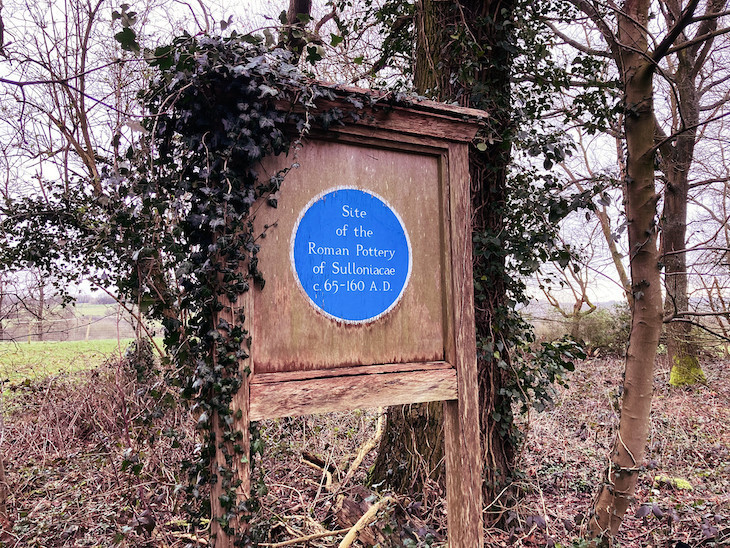For many of us, a trip to the very northern extreme of the Jubilee line would be adventure enough. How often do you take a ride out to Stanmore for the fun of it? But add to that a walk of over a mile up one of north London’s tallest hills, and then a scramble through a patch of overgrown brambles and you might find this:

It’s what I like to think of as London’s most inconvenient plaque, and probably one of the least visited. It marks the lost Roman pottery (and possibly settlement) of Sulloniacis. Actually, it's not even a proper plaque - more a disc of paint on wooden board, styled to look like an English Heritage Blue Plaque. Humble and remote the memorial may be, but it does mark one of Roman London's most important outposts.

A Forgotten Roman Settlement
To back up a bit, the site is on top of Brockley Hill, part of the slopes north of Stanmore that form the highest ridge in north London (and nothing to do with the better-known Brockley in Lewisham). You’ll find the plaque just across the road from the Royal Orthopaedic Hospital. Wear jeans and tough shoes, though, because those brambles really mean business.

So what do we know about this mysterious lost landmark of Roman Britain? Sulloniacis is documented in only one source — the Antonine Itinerary, a kind of early routefinder, which listed out distances between towns and stopping points. Its author is unknown and its date of compilation is also unresolved, though it’s traditionally pinned to the reign of Emperor Antoninus Pius (138 to 161 CE).
In that text, Sulloniacis is given as nine Roman miles from Verulamium (St Albans) and 12 from Londinium (London). It's not clear if this was a proper settlement, or simply a resting point for the horse-drawn traffic out of the city. Either way, the most likely site falls beside the ancient Watling Street, the north-south route that still punches out of London as a continuation of Edgware Road. Its location on top of Brockley Hill, already established by tradition, was given added weight in 1937, when a series of Roman pottery kilns was found near the crest. It is this archaeological site that is marked by the blue plaque.
Ancient Pottery
Sulloniacis was probably named after a Roman settler called Sullonios, though it may alternatively be a Roman corruption of an existing Celtic place name. It seems to have been a very important pottery site. The hilltop location provided abundant clay, while natural springs could be tapped by wells. The pottery seems to have been set up around 60 CE, little more than a decade after the founding of Londinium. Its location beside Watling Street would have been ideal for transport.
Archaeology suggests that the pottery flourished for about 100 years, and seems to have been the best place in England to get a mortarium — a rough-based bowl for pounding food. The kilns were extinguished by about 160 CE, but the site remained occupied into the 4th Century.
A Nearby Battle
There’s only so much enjoyment to be gained from standing in a bramble patch admiring a minimal blue plaque. If you’re ever up this way, you should also do a detour through the hospital grounds, which conceal another site of Roman connection. This little-known obelisk marks the supposed site of the decisive battle between Julius Caesar and the local chieftain Cassivellaunus (the first named individual we know of in Britain). That scrap took place in 54 BCE, shortly before Caesar withdrew his armies. This was all around 100 years before the Romans came to stay and set up their pottery on practically the same spot.

Today, there’s little else beside the 'plaque' on Brockley Hill to indicate that it was once home to one of the region’s most important potteries. However, if you descend down into modern Stanmore, you might chance across these oversized storage jars beside the local Sainsbury’s. This sculptural work by Diane Maclean was inspired by the ancient pottery site, and was funded by the supermarket and Harrow Heritage Trust.
To find the site of Sullloniacis, either take the Northern line to Edgware then get the 107 up to the Royal Orthopaedic Hospital; or else take the Jubilee to Stanmore and then walk up through the exceptional Stanmore Country Park (which, to be honest, is a much better use of your time unless you're into extreme plaque hunting).




